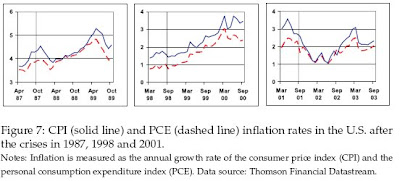"All three historical episodes of liquidity crises demonstrate that central banks, and in particular the Fed under Alan Greenspan, stand ready to provide liquidity in times of financial crises. Greenspan (2004, p. 38) states that the ‘immediate response on the part of the central bank to such financial implosions must be to inject large quantities of liquidity,’ in line with the traditional Bagehot (1873) principle for a lender of last resort activity to ‘lend freely at a high rate against good collateral.’ At first sight, this seems to be a simple panacea for central banks to respond to temporary liquidity crises on financial markets as central banks seem to provide liquidity at no costs.
However, liquidity provision is not costless and central banking is not that simple. Depending on the nature of the liquidity shock, it may take some time until market turmoils have seized and the central bank can withdraw its liquidity injections. The longer the additional liquidity circulates in the financial system, the more it will spill over into the ‘real’ economy, fuel goods price inflation and thus raise the costs of the intervention. The aftermaths of the stock market crash in 1987 and the LTCM crisis in 1998 provide evidence for this mechanism, whereas the liquidity effects of the terrorist attacks on September 11, 2001, have been rather limited."
September 11 occurred when the U.S. was already in recession, so any delay in withdrawing liquidity did not stimulate inflation. In fact, the cuts in the federal funds rate following September 11 were exactly what the economy needed anyway (according to the Taylor Rule), as seen at the right of Figure 6. The other two crises occurred when the U.S. was already near the end of a long boom period, just when inflationary forces are starting to build up. In each case the Fed kept the federal funds rate well below what the Taylor Rule would have suggested for several months (see Table 6), and as a result inflation took off (see Table 7).
So is the U.S. currently in or on the verge of recession, or are we near the end of a long economic boom? We don't know, but we'll find out eventually - of course by then it will be too late .
So is the U.S. currently in or on the verge of recession, or are we near the end of a long economic boom? We don't know, but we'll find out eventually - of course by then it will be too late .













0 comments:
Post a Comment